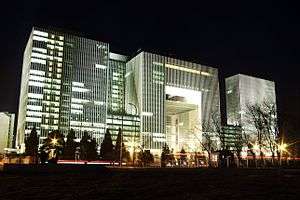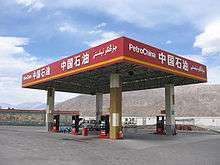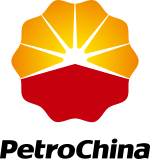PetroChina
|
| |
|
Public SEHK: 0857 SSE: 601857 NYSE: PTR | |
| Industry | Oil and gas |
| Founded | November 5, 1999 |
| Headquarters | Dongcheng District, Beijing, China |
Area served | China |
Key people |
Zhou Jiping (Chairman); Wang Dongjin (CEO)[1] |
| Products | Fuels, lubricants, natural gas and other petrochemicals |
| Revenue | US$367.982 billion (2014) |
|
| |
|
| |
| Total assets |
|
| Total equity |
|
Number of employees | 534,652 (2015)[2] |
| Parent | China National Petroleum Corporation |
| Website | petrochina.com.cn/ptr/ |
PetroChina Company Limited (simplified Chinese: 中国石油天然气股份有限公司; traditional Chinese: 中國石油天然氣股份有限公司; Uyghur: چوڭگو نېفتى) is a Chinese oil and gas company and is the listed arm of state-owned China National Petroleum Corporation (CNPC), headquartered in Dongcheng District, Beijing.[3] It is China's biggest oil producer.[4] Traded in Hong Kong and New York, the mainland enterprise announced its plans to issue stock in Shanghai in November 2007,[4] and subsequently entered the constituent of SSE 50 Index.
History

PetroChina was established as a joint stock company with limited liabilities under the Company Law of the People's Republic of China (the PRC) on November 5, 1999, as part of the restructuring of CNPC. In the restructuring, CNPC injected into PetroChina most of the assets and liabilities of CNPC relating to its exploration and production, refining and marketing, chemicals and natural gas businesses.
Although PetroChina is the most profitable company in Asia, this success may be the result of corporate management, but can also be attributed to the near duopoly on the wholesale and retail business of oil products it shares with Sinopec in China.
Because of Sinopec's link to Sudan through parent company China Petrochemical Corporation, several institutional investors such as Harvard and Yale decided, in 2005, to divest from Sinopec. Sudan divestment efforts have continued to be concentrated on PetroChina since then.[5] Fidelity Investments, after pressure from activist groups, also announced in a filing in the US that it had sold 91 per cent of its American Depositary Receipts in PetroChina in the first quarter of 2007.[6]
At the beginning of May 2007, the company announced it had made China's largest oil find in a decade off the country's northeast coast, in an oilfield named Jidong Nanpu in Bohai Bay.[7] In May 2008 these expectations were lowered.[8]
On November 7, 2007, Hang Seng Index Services Company announced that PetroChina would be a Hang Seng Index Constituent Stock, effective December 10, 2007.[9] PetroChina has also come under scrutiny from international organizations for its part in trading with the Sudanese government who continues the ongoing war in Darfur.
On August 19, 2009, PetroChina signed an A$50 billion deal with ExxonMobil to purchase liquefied natural gas from the Gorgon field in Western Australia,[10][11] considered the largest contract ever signed between China and Australia, which ensures China a steady supply of LNG fuel for 20 years, and also forms as China's largest supply of relatively "clean energy".[12][13] This deal has been formally secured, despite relations between Australia and China being at their lowest point in years, following the Rio Tinto espionage case and the granting of visas to Rebiya Kadeer to visit Australia.[14]
PetroChina's Dushanzi District refinery became fully operational on September 24, 2009. The refinery is China's largest refinery with annual capacity of 10 million tons of oil and 1 million tons of ethylene. The refinery is an integral part of China's ambitions to import oil from Kazakhstan.[15]
February 2011: PetroChina agreed to pay $5.4 billion for a 49% stake in Canada's Duvernay shale assets owned by Encana. It is the China's biggest investment in shale gas to date.[16] PetroChina's subsidiary in Canada is named Phoenix Energy Holdings and has an office in the Sun Life Tower at 140-4th Ave SW in Calgary. It operates under the direction of Li Zhiming as Brion Energy.[17]
Environmental record
PetroChina is promoting safety, environmental protection and people-orientation as its slogan and is determined to encourage efficiency in utilization of resource as well as effective operation of the Health, Safety and Environment (HSE) management system as a method to reduce emission of pollutants.[18]
Chemical spills
Petrochina had a chemical spill in November, 2005. One of its chemical plants exploded in Jilin, China, resulting in 100 tons of benzene, which is a carcinogen and toxic, pouring into the Songhua River. There was a slick of chemicals that spanned 80 kilometres.[19] Harbin, which is another city along the Songhua River, had to cut the water supply from almost 4 million people, for 5 days. More than 60 people were injured, five died, and one person was missing due to the incident.[20] The spill prompted China’s environmental agency to fine the company one million yuan (approximately $125,000, £64,000) for its pollution, which was the maximum fine that can be handed out in China for breaking an environmental law.[21] However, this disaster sparked controversy about this law. People claimed the law was too soft.[22] The spill even crept into Khabarovsk, Russia, where residents stocked up on bottled water. The city tried filtering its water of toxic substances, but officials were still unsure if the water was 100% safe for drinking.[23] The Chinese government said it will take more than one billion dollars to clean up the aftermath.[19] Li Zhaoxing, Chinese Foreign Minister at the time, issued a public apology to Russia due to the incident.[24]
In 2014, Petrochina's subsidiary Lanzhou Petrochemical was responsible for ethylene and ammonia leaks, benzene contamination of water supplies, and air pollution in Lanzhou. The city government criticized the company and demanded an apology. [25]
The "Western Gas to the East" Pipeline Project

Another major controversial issue is PetroChina’s development in gas reserves in Tarim Basins, Xinjiang. It is argued that such a project might pose a threat to the environment, as the construction of the pipeline might affect the wildlife in the regions where it runs through. However, no known environmental or social impact assessments have been conducted, as the environmental record of Tarim Basins is very poor.[26]
Demonstration at new plant
Approved in 2007, a $5.5 billion petrochemical plant, expected to produce 800,000 tons of ethylene and refine 10 million tons of crude oil a year, is now under construction by PetroChina in Chengdu, provincial capital of Sichuan in Southwestern China. Ethylene is widely used in the production of goods such as packaging and trash liners. Although the project claimed that $565 million of the total investment would be dedicated to environmental protection, residents of Chengdu who believe it might bring pollution to the local area took to the streets on May 3 and 4, 2008, to protest against the project. The whole demonstration was peaceful, and presence of Chinese government intervention was scarce.[27]
Recognition
- Forbes published its latest ranking of the “Forbes 2000 The World’s Leading Companies”. The company ranked 8th in the world for public companies.[28]
Corporate bonds
PetroChina, on October 24, 2008 issued an 80 billion yuan ($11.7 billion) of medium-term corporate bonds, which was the biggest ever domestic issue by a listed company. China in 2016 signed a deal with Nepal Oil Corporation to sell 30% Of the total petroleum consumption in Nepal. China will build a pipeline up to Nepal's Panchkhal and make a storage depot.[29]
Logo
The logo of PetroChina has represented the company in plenary capacity since 2004. The logo's basic, abecedarian design consists of a rising sun, projected onto a petal-based graphic. The colors utilized in the graphic are red and yellow, auspicious in Chinese culture. Beneath the English-language version of the design is positioned the company's name in an emboldened, black typeset, "PetroChina" (Chinese: 中国石油; pinyin: Zhōngguó shíyóu).
PetroChina's current logo was adopted 26 December 2004. The contour of the logo is defined as a "petal graphic equally divided by ten in red and yellow colors", which, according to description, "are the basic colors of the national flag of the People's Republic of China, and which embody the characteristics of the oil and gas industry." The essentially spherical design of the logo, meant to exemplify PetroChina's global development stratagem. The ten equanimous petals are indicative of PetroChina's ten consolidated core businesses. The red substratum is intended to highlight "an angle of a square shape, not only demonstrating PetroChina's strong fundamentals, but also implicating the company's huge power of cohesion and creativity." The general floral connotations of the logo are designed to capture PetroChina's "social responsibility of creating harmony between energy and environment." Finally, the sun ascending over the horizon in the center of the logo epitomizes the prosperous future hoped to lie within the future of PetroChina.[30]
See also
References
Citations
- ↑ {http://www.petrochina.com.cn/ptr/ldjs/ldjs.shtml}
- 1 2 3 4 5 6 "PetroChina Company Limited". Google. Retrieved 27 June 2012.
- ↑ "Contact Us." PetroChina. Retrieved on July 8, 2010. "Address: 9 Dongzhimen North Street, Dongcheng District, Beijing, P.R.China."
- 1 2 Analysts express optimism about Chinese shares (Xinhuanet.com, with source from Shanghai Daily)
- ↑ Response to Berkshire Hathaway's statement on its holdings in PetroChina Company Limited, Sudan Divestment Task Force, 2007-02-23. Retrieved on 2007-03-28.
- ↑ "Darfur activists claim Fidelity success". Financial Times.
- ↑ "China claims major oil field find". BBC News. May 4, 2007. Retrieved May 22, 2010.
- ↑ China: PetroChina's Jidong Nanpu oil field smaller than originally thought" 28 May 2010
- ↑ HSI SERVICES ANNOUNCES INDEX REVIEW RESULTS
- ↑ Stephen McDonell, August 19, 2009, Record gas deal between China and Australia - AM - Australian Broadcasting Corporation
- ↑ Babs McHugh, August 19, 2009, Massive sale from Gorgon Gas Project - Australian Broadcasting Corporation
- ↑ David McLennan, August 20, 2009, Australia to be 'global supplier of clean energy' - The Canberra Times
- ↑ August 20, 2009, CNPC to import 2.25m tons of LNG annually from Australia - ChinaDaily (Source: Xinhua)
- ↑ Peter Ryan, August 19, 2009, Deal means 2.2 million tonnes exported per year - AM - Australian Broadcasting Corporation
- ↑ PetroChina Activates China's Biggest Refinery - The China Perspective
- ↑ PetroChina in $5.4bn Canada gas buy http://www.ft.com/cms/s/0/94826968-34ab-11e0-9ebc-00144feabdc0.html?ftcamp=rss#axzz1DYRcqdDL
- ↑ "Brion Energy" about us page.
- ↑ http://www.petrochina.com.cn/resource/EngPdf/LTN20080319139.pdf "Summary of the 2007 Annual Report". PetroChina.com.cn, May 5, 2008
- 1 2 "Maximum fine over China pollution". BBC News. January 25, 2007. Retrieved May 22, 2010.
- ↑ The Epoch Times | Jilin PetroChina Explosion Under Investigation, Vice-Mayor of Jilin City Reported Dead
- ↑ "Maximum fine over China pollution". BBC News. January 25, 2007. Retrieved 2013-05-14.
- ↑ PetroChina branch fined for pollution
- ↑ "Toxic leak reaches Russian city". BBC News. December 22, 2005. Retrieved May 22, 2010.
- ↑ Bezlova, Antoaneta (December 2, 2005). "China's toxic spillover". Asia Times. Retrieved 2013-05-14.
- ↑ He Huifeng (January 11, 2015). "Chinese city lashes PetroChina unit over chemical leaks". South China Morning Post. Retrieved 2015-02-10.
- ↑ http://trilliuminvest.com/resolutions/human-rights-1/ "Divest From PetroChina - BP Amoco". Trilliuminvest.com. May 4, 2008
- ↑ Wong, Edward (May 6, 2008). "In China City, Protesters See Pollution Risk of New Plant". The New York Times. Retrieved 2013-05-14.
- ↑ "The Global 2000". Forbes. April 8, 2009.
- ↑ http://news.xinhuanet.com/english/2008-10/21/content_10230506.htm
- ↑ "PetroChina launches new logo". PetroChina. Retrieved 29 July 2013.
Sources
- 2004 Annual Report, pp. 135, 137
- McGregor, Richard. The Party: The Secret World of China's Communist Rulers. Harper Perennial: New York, 2012. ISBN 978-0-06-170876-3. Originally published in 2010 by Allen Lane, a Penguin Books imprint.
External links
- Official website (English)
- Official website (Chinese)
- PetroChina stock quote Google Finance
